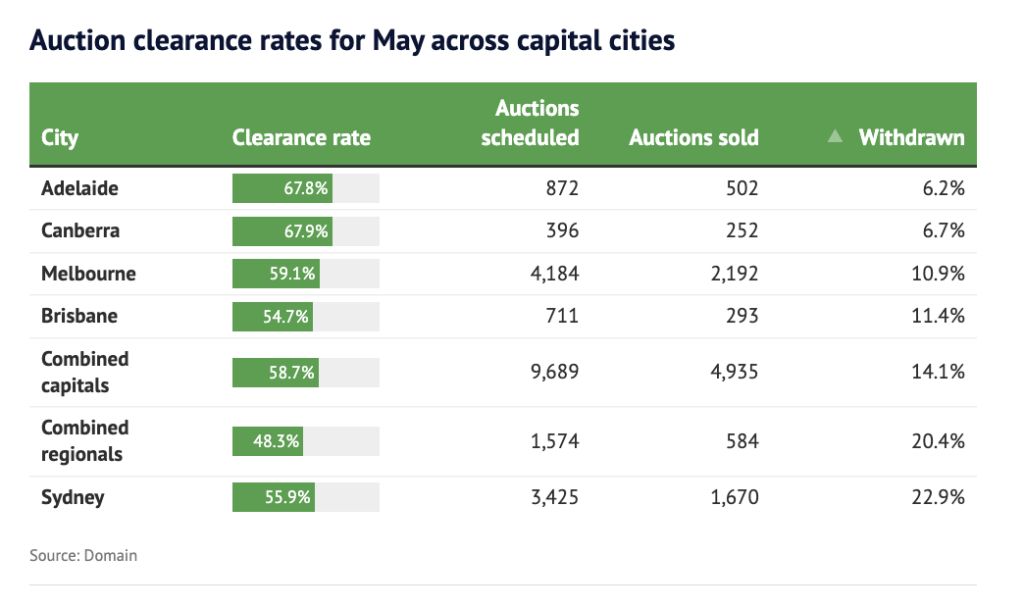‘A very clear jolt’: Why house prices are tipped to fall even further

Home sellers could face tough decisions in coming months, as auction clearance rates dip below 60 per cent in Sydney and Melbourne, pointing to further falls in property prices.
Some vendors may decide to change their plans and hold off listing their home, while others may choose to simply go ahead to cash in before prices fall further.

Sydney’s clearance rates for May fell to 55.9 per cent, while Melbourne’s sank to 59.1 per cent, their lowest point for the past 12 months in Domain data. Brisbane, where the clearance rate was 54.7 per cent, and Canberra at 67.9 per cent also recorded their lowest point for the year.
Clearance rates are an indicator of whether the property market is rising, falling or remaining steady, with rates above 70 per cent pointing to an annual house price rise of at least 10 per cent. Anything below 60 per cent broadly points to a fall in prices and a weakening market.
Domain chief of research and economics Dr Nicola Powell said listings were up in May, meaning more choice for home buyers still in the market.
“Clearance rates have fallen below 70 per cent in all capital cities this month as a result of more homes on the market but reduced competition among buyers, highlighting the overall slowdown in the property market,” Powell said.

“The gradual shift to a buyers’ market could see a continual run of softening clearance rates, reduced choice among buyers and a change in seller price expectations.”
Economists expect weakening clearance rates to continue this year, with the first weekend in June recording a preliminary clearance rate of 55 per cent in Sydney and 59 per cent in Melbourne. Both were expected to be revised lower, possibly below 50 per cent in Sydney, as more results were received.
Agents and auctioneers say that selling is becoming tougher than last year, as buyers become more discerning and fear of missing out changes to fear of overpaying.
Added building costs are also deterring bidders who once loved to find a fixer-upper to make their own.

Westpac senior economist Matthew Hassan said the first official interest rate rise by the Reserve Bank of Australia in May was a shock to the market.
“It’s a very clear jolt to the market,” Hassan said. “It’s really due to the rate move and the wider expectations that the cost of living is rising and there are more rate rises to come.”
Hassan said clearance rates were falling while there had also been a sharp rise in withdrawn auctions in May. In Sydney, the number of withdrawn auctions doubled on April’s figures, Domain data shows.
“From a seller’s perspective, they are facing a quandary: do they take the hit and sell, or wait possibly for the next two to three years for things to improve?” Hassan said.
AMP Capital chief economist Shane Oliver said home sellers and buyers could expect clearance rates to bottom out about 40 per cent over the next 12 to 18 months, similar to previous market downturns.
With the Reserve Bank meeting on Tuesday, and interest rates likely to rise again, buyers’ potential borrowing power could take a further hit.
“The rise in interest rates is having an impact on the market a lot earlier than in the past,” Oliver said. “That’s because around 45 per cent of new lending is through fixed-rate loans, where interest rates rose before the RBA’s official hike in May.”
Oliver said clearance rates would fall further, but not as far as they had during pandemic lockdowns, where some had fallen as low as the 20 per cent range.
“I think we will go down to the low forties and spend time bouncing around the bottom until recovery starts,” he said. “We’ve still got a bit more damage to come.”
We recommend
We thought you might like
States
Capital Cities
Capital Cities - Rentals
Popular Areas
Allhomes
More










